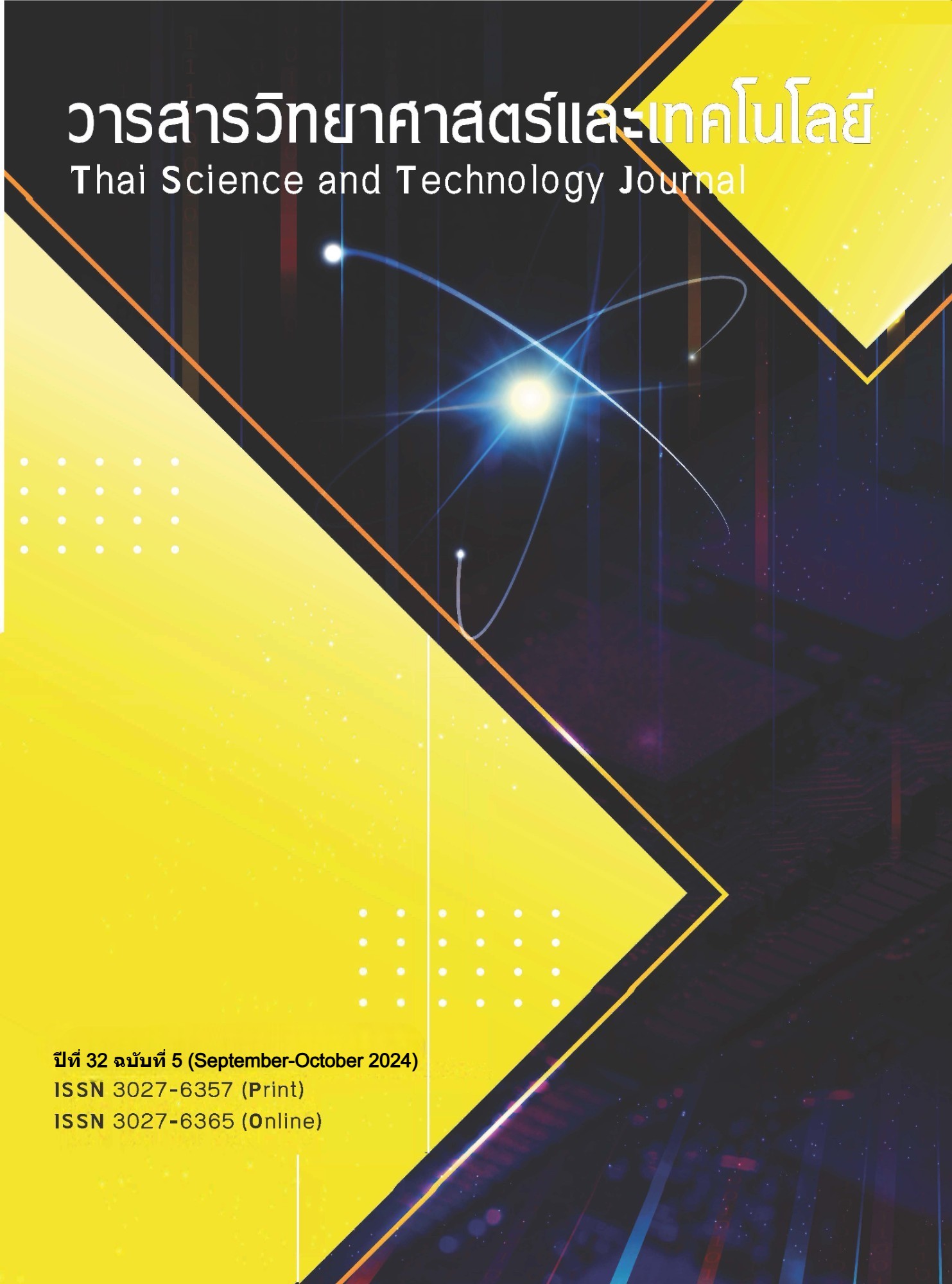The Release of Silver Nanoparticles and Antibacterial Properties of Hydrogel Sheet Dressings
Main Article Content
Abstract
Recently theuseof silver nanoparticles (AgNPs) in wound dressings has attracted considerable attention due to their potent antibacterial properties. The aim of this research was to investigate the release of AgNPs from hydrogel dressings by inductively coupled plasma-mass spectrometry (ICP-MS) analysis and their antibacterial properties by disc diffusion assay.Freeze-thawing and electron beam (EB) irradiation techniques were used to crosslink hydrogel patches composed of silvernitrate atvaried concentrations. During EB irradiation silver nitrate was reduced to AgNPs within the hydrogel matrices. Although UV-Vis spectroscopy showed the characteristics absorbance peaked at 410 nm from all AgNPs-embedded hydrogels, the disc diffusion assay showed the formationof a clear zone
without bacteria only for hydrogels with AgNPs at the two highest concentrations, 0.5 and 1.0 mg/cm2 ,against both Staphylococcus aureusand Escherichia coli.The corresponding amounts of released AgNPs were ~ 65 and 225 ppm, respectively, as analyzed by ICP-MS. Taken together, the AgNPs-loaded hydrogels developed by freeze-thawing and EB irradiation techniques in this study have potential as antibacterial wound dressings
Article Details
References
Rai, M., Kon K., Ingle A., Duran N., Galdiero S. and Galdiero M., 2014, Broad-spectrum bioactivities of silver nanoparticles: the emerging trends and future prospects, Appl Microbiol. Biotechnol. 98: 1951-1961.
Prabhu, S. and Poulose, E.K., 2012, Silver nanoparticles: mechanism of antimicrobial action, synthesis, medical applications, and toxicity effects, Int. Nano Lett. 2: 1-10.
Li, R., Chen, J., Cesario, T.C., Wang, X., Yuan, J.S. and Rentzepis, P.M., 2016, Synergistic reaction of silver nitrate, silver nanoparticles, and methylene blue against bacteria, PNAS. 113(48): 13612-13617.
Hasan, T., Al-Harmoosh, R. and Al-Khilkhali, H., 2020, Identification of HIV virus in najaf city, Iraq, Int. J. Res. Pharm. Sci. 11(3): 4866-4871.
Grzelczak, M. and Liz-Marzán, L.M., 2014, The relevance of light in the formation of colloidal metal nanoparticles, Chem. Soc. Rev. 43: 2089-2097.
Kim, S.-E., Park, J.H., cheol Lee, B., Lee, J.-C. and Kwon, Y.K., 2012, Large-scale synthesis of silver nanoparticles using Ag (I)–S12 polymer through electron beam irradiation, Radiat. Phys. and Chem. 81(8): 978-981.
Alcântara, M.T.S., Lincopan, N., Santos, P.M., Ramirez, P.A., Brant, A.J.C., Riella, H.G. and Lugao, A.B., 2020, Simultaneous hydrogel crosslinking and silver nanoparticle formation by using ionizing radiation to obtain antimicrobial hydrogels, Radiat. Phys. Chem. 169: 108777.
Thanh, N.T., Maclean, N. and Mahiddine, S., 2014, Mechanisms of nucleation and growth of nanoparticles in solution, Chem. Rev. 114(15): 7610-7630.
Nikolić, N., Spasojević, J., Radosavljević, A., Milošević, M., Barudžija, T., Rakočević, L. and Kačarević-Popović, Z., 2023, Influence of poly (vinyl alcohol)/poly (N-vinyl-2-pyrrolidone) polymer matrix composition on the bonding environment and characteristics of Ag nanoparticles produced by gamma irradiation, Radiat. Phys. Chem. 202: 110564.
Yin, I.X., Zhang, J., Zhao, I.S., Mei, M.L., Li, Q. and Chu, C.H., 2020, The antibacterial mechanism of silver nanoparticles and its application in dentistry, Int. J. Nanomedicine. 2555-2562.
Laurano, R., Boffito, M., Ciardelli, G. and Chiono, V., 2022, Wound dressing products: A translational investigation from the bench to the market, ER. 3(2): 182-200.
Chiangnoon, R., Karawak, P., Eamsiri, J., Nuchdang, S., Thamrongsiripak, N., Neramitmansook, N., Pummarin, S., Pimton, P., Nilgumhang, K. and Uttayarat, P., 2023, Antibacterial Hydrogel Sheet Dressings Composed of Poly (vinyl alcohol) and Silver Nanoparticles by Electron Beam Irradiation, Gels. 9(2): 80.
Husain, M.S.B., Gupta, A., Alashwal, B.Y. and Sharma, S., 2018, Synthesis of PVA/PVP based hydrogel for biomedical applications: a review, Energy Sources A: Recovery Util. Environ. Eff. 40(20): 2388-2393.
Gupta, S., Goswami S. and Sinha A., 2012, A combined effect of freeze--thaw cycles and polymer concentration on the structure and mechanical properties of transparent PVA gels, Biomed Mater. 7(1): 015006.
Adelnia, H., Ensandoost, R., Moonshi, S.S., Gavgani, J.N., Vasafi, E.I. and Ta, H.T., 2022, Freeze/thawed polyvinyl alcohol hydrogels: Present, past and future, Eur. Polym. J. 164: 110974.
Kamoun, E.A., Chen, X., Eldin, M.S.M. and Kenawy, E.R.S., 2015, Crosslinked poly (vinyl alcohol) hydrogels for wound dressing applications: A review of remarkably blended polymers, Arab. J. Chem. 8(1): 1-14.
Nho, Y.C., Lim Y.M., Gwon H.J. and Choi E.K., 2009, Preparation and characterization of PVA/PVP/glycerin/antibacterial agent hydrogels using -irradiation followed by freeze-thawing, Korean J Chem Eng. 26: 1675-1678.
Silindir, M. and Özer A.Y., 2009, Sterilization methods and the comparison of E-beam sterilization with gamma radiation sterilization, Fabad J. Pharm. Sci. 34(1): 43.
Uttayarat, P., Eamsiri, J., Tangthong, T. and Suwanmala, P., 2015, Radiolytic synthesis of colloidal silver nanoparticles for antibacterial wound dressings, Adv. Mater. Sci. Eng. 2015.
Uttayarat, P., Jetawattana, S., Suwanmala, P., Eamsiri, J., Tangthong, T. and Pongpat, S., 2012, Antimicrobial electrospun silk fibroin mats with silver nanoparticles for wound dressing application. Fibers Polym. 13(8): 999-1006.
Badi’ah, H., Seedeh, F., Supriyanto, G. and Zaidan, A., 2019, Synthesis of silver nanoparticles and the development in analysis method. in IOP Conference Series: Earth and Environmental Science, IOP Publishing.
Bhowmick, S. and Koul, V., 2016, Assessment of PVA/silver nanocomposite hydrogel patch as antimicrobial dressing scaffold: Synthesis, characterization and biological evaluation, Mater. Sci. Eng. C. 59: 109-119.
Paladini, F. and Pollini M., 2019, Antimicrobial silver nanoparticles for wound healing application: progress and future trends, Materials. 12(16): 2540.
Novientri, G., Abbas G.H. and Budianto E., 2019, Nanocomposite hydrogel-based biopolymer modified with silver nanoparticles as an antibacterial material for wound treatment, J. Appl. Pharm. Sci. 9(11): 001-009.


